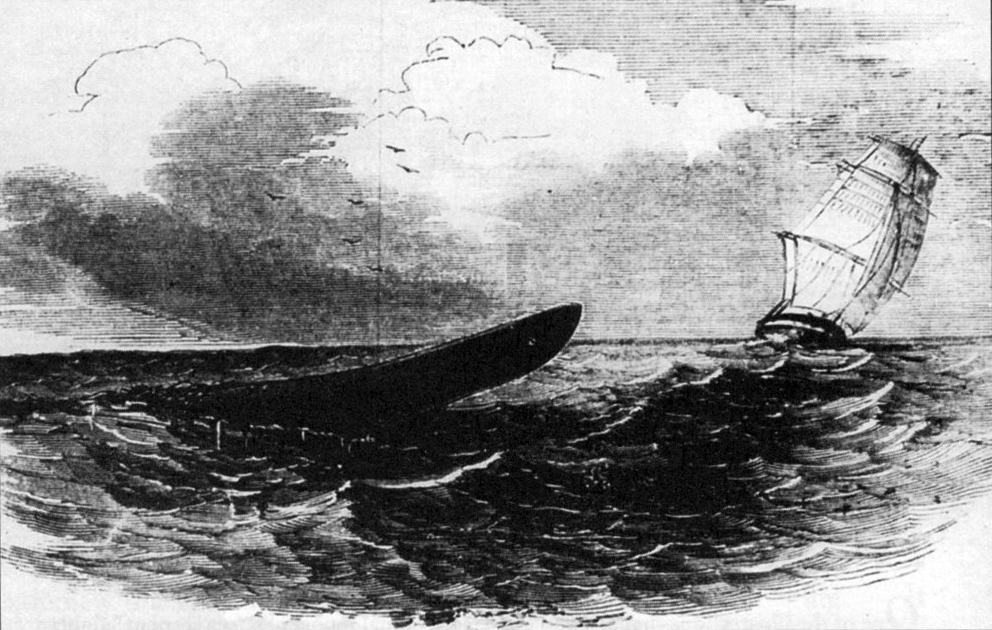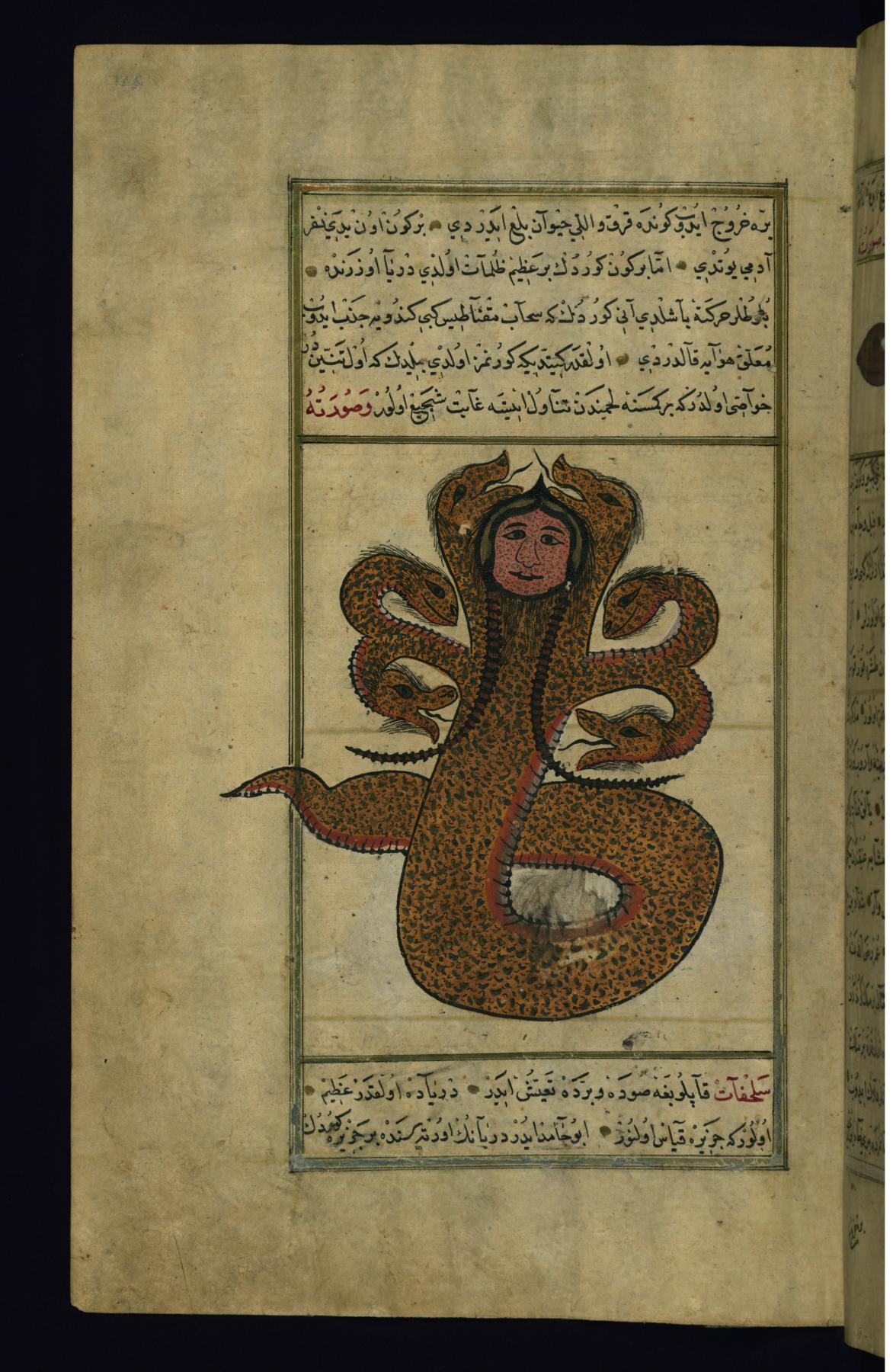|
Sea Serpent
A sea serpent or sea dragon is a type of dragon sea monster described in various mythologies, most notably Mesopotamian (Tiamat), Judaeo-Christian (Leviathan), Greek (Cetus, Echidna, Hydra, Scylla), and Norse (Jörmungandr). Mythology and folklore Mediterranean and Western Asia The mytheme, the chief god in the role of the hero slaying a sea serpent, is widespread both in the ancient Near East and in Indo-European mythology, e.g. Lotan and Hadad, Leviathan and Yahweh, Tiamat and Marduk (see also Labbu, Bašmu, Mušḫuššu), Illuyanka and Tarhunt, Yammu and Baal in the Baal Cycle etc. The Hebrew Bible also has less mythological descriptions of large sea creatures as part of creation under God's command, such as the Tanninim mentioned in Book of Genesis 1:21 and the "great serpent" of Amos 9:3. In the Aeneid, a pair of sea serpents killed Laocoön and his sons when Laocoön argued against bringing the Trojan Horse into Troy. In antiquity and in the Bible, dragons were ... [...More Info...] [...Related Items...] OR: [Wikipedia] [Google] [Baidu] |
Olaus Magnus
Olaus Magnus (October 1490 – 1 August 1557) was a Swedish writer, cartographer, and Catholic ecclesiastic. Biography Olaus Magnus (a Latin translation of his birth name Olof Månsson) was born in Linköping in October 1490. Like his elder brother, Sweden's last Catholic archbishop Johannes Magnus, he obtained several ecclesiastical preferments, among them a canonry at Uppsala and Linköping, and the archdeaconry of Strängnäs. He was furthermore employed on various diplomatic services after his mission to Rome in 1524, on behalf of Gustav I of Sweden (Vasa), to procure the appointment of Olaus Magnus' brother Johannes Magnus as archbishop of Uppsala. He remained abroad dealing with foreign affairs and is known to have sent home a document that contained agreed trade-relations with the Netherlands. With the success of the reformation in Sweden, his attachment to the Catholic church led him to stay abroad for good where he accompanied his brother in Poland. They were both exi ... [...More Info...] [...Related Items...] OR: [Wikipedia] [Google] [Baidu] |
Yahweh
Yahweh *''Yahwe'', was the national god of ancient Israel and Judah. The origins of his worship reach at least to the early Iron Age, and likely to the Late Bronze Age if not somewhat earlier, and in the oldest biblical literature he possesses attributes typically ascribed to weather and war deities, fructifying the land and leading the heavenly army against Israel's enemies. The early Israelites were polytheistic and worshipped Yahweh alongside a variety of Canaanite gods and goddesses, including El, Asherah and Baal. In later centuries, El and Yahweh became conflated and El-linked epithets such as El Shaddai came to be applied to Yahweh alone, and other gods and goddesses such as Baal and Asherah were absorbed into Yahwist religion. Towards the end of the Babylonian captivity, the very existence of foreign gods was denied, and Yahweh was proclaimed as the creator of the cosmos and the one true God of all the world, giving birth to Judaism, which has 14–15 ... [...More Info...] [...Related Items...] OR: [Wikipedia] [Google] [Baidu] |
Aeneid
The ''Aeneid'' ( ; la, Aenē̆is or ) is a Latin epic poem, written by Virgil between 29 and 19 BC, that tells the legendary story of Aeneas, a Trojan who fled the fall of Troy and travelled to Italy, where he became the ancestor of the Romans. It comprises 9,896 lines in dactylic hexameter. The first six of the poem's twelve books tell the story of Aeneas' wanderings from Troy to Italy, and the poem's second half tells of the Trojans' ultimately victorious war upon the Latins, under whose name Aeneas and his Trojan followers are destined to be subsumed. The hero Aeneas was already known to Greco-Roman legend and myth, having been a character in the ''Iliad''. Virgil took the disconnected tales of Aeneas' wanderings, his vague association with the foundation of Rome and his description as a personage of no fixed characteristics other than a scrupulous ''pietas'', and fashioned the ''Aeneid'' into a compelling founding myth or national epic that tied Rome to the lege ... [...More Info...] [...Related Items...] OR: [Wikipedia] [Google] [Baidu] |
Book Of Genesis
The Book of Genesis (from Greek ; Hebrew: בְּרֵאשִׁית ''Bəreʾšīt'', "In hebeginning") is the first book of the Hebrew Bible and the Christian Old Testament. Its Hebrew name is the same as its first word, ( "In the beginning"). Genesis is an account of the creation of the world, the early history of humanity, and of Israel's ancestors and the origins of the Jewish people. Tradition credits Moses as the author of Genesis, as well as the books of Exodus, Leviticus, Numbers and most of Deuteronomy; however, modern scholars, especially from the 19th century onward, place the books' authorship in the 6th and 5th centuries BC, hundreds of years after Moses is supposed to have lived.Davies (1998), p. 37 Based on scientific interpretation of archaeological, genetic, and linguistic evidence, most scholars consider Genesis to be primarily mythological rather than historical. It is divisible into two parts, the primeval history (chapters 1–11) and the anc ... [...More Info...] [...Related Items...] OR: [Wikipedia] [Google] [Baidu] |
Tannin (monster)
Tannin ( he, תַּנִּין ''tannīn''; syr, ܬܢܝܢܐ ''tannīnā'' plural: ''tannīnē''; ar, التنين ', ultimately from Akkadian 𒆗𒉌𒈾 ''dannina'') or Tunnanu (Ugaritic: 𐎚𐎐𐎐 ''tnn'', likely vocalized ''tunnanu'') was a sea monster in Canaanite and Hebrew mythology used as a symbol of chaos and evil. Canaanite mythology Tannin appears in the Baal Cycle as one of the servants of Yam () defeated by Baʿal () or bound by his sister, Anat. He is usually depicted as serpentine, possibly with a double tail. Hebrew mythology The ''tanninim'' () also appear in the Hebrew Bible's Book of Genesis,. Exodus, Deuteronomy, Psalms, Job, Ezekiel, Isaiah, and Jeremiah. They are explicitly listed among the creatures created by God on the fifth day of the Genesis creation narrative, translated in the King James Version as "great whales". The tannin is listed in the apocalypse of Isaiah as among the sea beasts to be slain by Yahweh "on that day", translated ... [...More Info...] [...Related Items...] OR: [Wikipedia] [Google] [Baidu] |
Hebrew Bible
The Hebrew Bible or Tanakh (;"Tanach" '' Random House Webster's Unabridged Dictionary''. Hebrew: ''Tānāḵh''), also known in Hebrew as Miqra (; Hebrew: ''Mīqrā''), is the canonical collection of Hebrew scriptures, including the Torah, the [...More Info...] [...Related Items...] OR: [Wikipedia] [Google] [Baidu] |
Baal Cycle
The Baal Cycle is an Ugaritic cycle of stories about the Canaanite god Baʿal ( "Owner", "Lord"), a storm god associated with fertility. It is one of the Ugarit texts, dated to c. 1500-1300 BCE. The text identifies Baal as the god Hadad, the Northwest Semitic form of Adad. The stories are written in Ugaritic, a Northwest Semitic language, and written in a cuneiform consonantal alphabet. It was discovered on a series of clay tablets found in the 1920s in the Tell of Ugarit (modern Ras Shamra), situated on the Mediterranean coast of northern Syria, a few kilometers north of the modern city of Latakia and far ahead of the current coastline. The stories include ''The Myth of Baʿal Aliyan'' and ''The Death of Baʿal''. Basic synopsis The Baʿal Cycle series of stories are summarized as: * Yam wants to rule over the other gods and be the most powerful of all * Baʿal Hadad opposes Yam and slays him * Baʿal Hadad, with the help of Anat and Athirat, persuades El to allow him ... [...More Info...] [...Related Items...] OR: [Wikipedia] [Google] [Baidu] |
Baal
Baal (), or Baal,; phn, , baʿl; hbo, , baʿal, ). ( ''baʿal'') was a title and honorific meaning "owner", "lord" in the Northwest Semitic languages spoken in the Levant during antiquity. From its use among people, it came to be applied to gods. Scholars previously associated the theonym with solar cults and with a variety of unrelated patron deities but inscriptions have shown that the name Ba'al was particularly associated with the storm and fertility god Hadad and his local manifestations. The Hebrew Bible includes use of the term in reference to various Levantine deities, often with application towards Hadad, who was decried as a false god. That use was taken over into Christianity and Islam, sometimes under the form Beelzebub in demonology. Etymology The spelling of the English term "Baal" derives from the Greek ''Báal'' ( which appears in the New Testament and Septuagint, and from its Latinized form ', which appears in the Vulgate. These forms in turn deri ... [...More Info...] [...Related Items...] OR: [Wikipedia] [Google] [Baidu] |
Yammu
Yam (also ''Yamm''; Semitic: ) is the god of the sea in the Canaanite pantheon. He takes the role of the adversary of Baal in the Ugaritic ''Baal Cycle''. The deity's name derives from the Canaanite word for "Sea", and is one name of the Ugaritic god of Rivers and Sea. Also titled ''ṯpṭ nhr'' (" the Judge of the River"), he is also one of the '' 'ilhm'', or sons of El, the name given to the Levantine pantheon. Of all the gods, despite being the champion of El, Yam holds special hostility against Baal Hadad, son of Dagon. He is a deity of the sea and his palace is in the abyss associated with the depths, or Biblical tehom, of the oceans. Yam is the deity of the primordial chaos and represents the power of the sea, untamed and raging; he is seen as ruling storms and the disasters they wreak, and was an important divinity to the maritime Phoenicians. The gods cast out Yam from the heavenly mountain Sappan (modern Jebel Aqra; ''Sappan'' is cognate to '' Tsephon''). The ... [...More Info...] [...Related Items...] OR: [Wikipedia] [Google] [Baidu] |
Illuyanka
In Hittite mythology, Illuyanka was a serpentine dragon slain by Tarḫunz (), the Hittite incarnation of the Hurrian god of sky and storm. It is known from Hittite cuneiform tablets found at Çorum-Boğazköy, the former Hittite capital Hattusa. The contest is a ritual of the Hattian spring festival of Puruli. The myth is found in ''Catalogue des Textes Hittites'' 321, which gives two consecutive versions. Name ''Illuyanka'' is probably a compound, consisting of two words for "snake", Proto-Indo-European ''*h₁illu-'' and ''*h₂engʷeh₂-''. The same compound members, inverted, appear in Latin ''anguilla'' "eel". The ''*h₁illu-'' word is cognate to English '' eel'', and ''*h₂engʷeh₂'' to Sanskrit ahi. Narrative In the first version, the Storm God and Illuyanka fight, and the serpent wins. The Storm God then goes to the Hattian goddess Inaras for advice. Having promised to sleep with a mortal named Hupasiyas in return for his help, she devises a trap for the dr ... [...More Info...] [...Related Items...] OR: [Wikipedia] [Google] [Baidu] |
Mušḫuššu
The ''mušḫuššu'' (; formerly also read as or ) or mushkhushshu ( or ), is a creature from ancient Mesopotamian mythology. A mythological hybrid, it is a scaly animal with hind legs resembling the talons of an eagle, lion-like forelimbs, a long neck and tail, a horned head, a snake-like tongue, and a crest. The most famously appears on the reconstructed Ishtar Gate of the city of Babylon, dating to the sixth century BCE. The form is the Akkadian nominative of sux, MUŠ.ḪUŠ, 'reddish snake', sometimes also translated as 'fierce snake'. One author, possibly following others, translates it as 'splendor serpent' ( is the Sumerian term for 'serpent'). The reading is due to a mistransliteration of the cuneiform in early Assyriology. History Mušḫuššu already appears in Sumerian religion and art, as in the " Libation vase of Gudea", dedicated to Ningishzida by the Sumerian ruler Gudea (21st century BCE short chronology). The was the sacred animal of Marduk and his ... [...More Info...] [...Related Items...] OR: [Wikipedia] [Google] [Baidu] |






